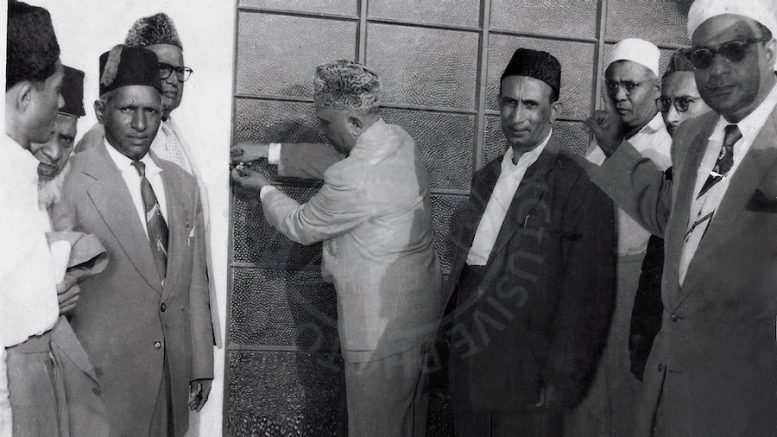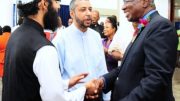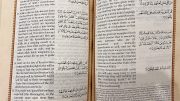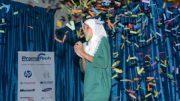First published in Barbados Today on February 22, 2017.
Nestled in a side street of our UNESCO World Heritage-inscribed capital city of Bridgetown is a place of worship. It stands oddly but proudly among the closely knit houses that make up that street called Sobers Lane.
For those Barbadians who may not know Sobers Lane, it is a widely traversed one-way route from Baxters Road to Whitepark Road. Parallel to Sobers Lane is Mahogany Lane and that runs one way the other way, offering drivers the route from Whitepark Road to Baxters Road or Tudor Street.
For those still not too familiar with Bridgetown, recall the old Public Library building and venture behind it to find these streets and this place of worship.
It was on February 7, 1957, some 60 years ago, that this place of worship or mosque was officially opened. It joined other iconic and historic religious buildings that make up the heart of Bridgetown and symbolized for Barbados a truly multi-faith and multi-cultural nation. In walking distance is the Jewish Synagogue, one of the oldest in the Western Hemisphere; the James Street Methodist Church; the St. Michael’s Cathedral; and St. Mary’s Church – three of the world’s great Abrahamic faiths and their places of worship finding a home in our capital city.
While the first known Muslim arrived on these shores around 1910, according to the book Bengal to Barbados by Sabir Nakhuda, and notwithstanding the strong possibility of Muslims among the slaves bought to the island from West Africa, it was not until the early 1950s that places were purchased solely for the purpose of setting up mosques. Prior to this period, Muslims prayed in various homes in The City. In March 1950, a group of Muslims, through donations from members, purchased a property situated at Sobers Lane. It consisted of a wooden house and land. The house would be the first official place of worship for Muslims on the island. In January 1951, the larger Jama Mosque was opened on Kensington New Road, having been purpose built.
The house on Sobers Lane served as a prayer place for Muslims for several years until, as Bengal to Barbados recalls, “they started to collect funds to demolish the house and build a masjid (mosque)”. Money was collected locally and from Muslims in the neighbouring countries of Trinidad, Guyana and Suriname, to help in funding the construction of the mosque. The late Ebrahim Degia who lived two houses away from the mosque on Sobers Lane was the driving force behind the project.
In February 1957, Mr S M Jaleel of Trinidad and Tobago along with Mr Degia and other Muslims, including my father, officially opened the mosque. Bengal to Barbados records a chartered plane of 80 Muslims coming to Barbados from Trinidad to witness the event. The City Mosque or City Masjid was its official name until ‘City’ was changed to its Arabic equivalent ‘Madina’. Masjid is the Arabic word for the place that Muslims worship. It literally means a ‘place of prostration’. Muslims put their foreheads on the ground in prostration as part of their worship. While the term mosque is used to describe the place of worship for Muslims in the dictionary, the term itself has its own orientalist interpretations, so most Muslims will prefer to say Masjid instead of Mosque.
The Madina Masjid (City Mosque) has served the Sobers Lane and surrounding communities in Bridgetown for the past 60 years. Its ornate structure of limestone blocks, purchased from quarries on the island, remains intact. Its original steel frame windows and doors are still in use. The symbolic minarets that rest on the roof are visible from a distance. The mosque was threatened by a major fire in the 1980s that destroyed the Geddes Grant warehouse right next door.

The Madina Masjid (City Mosque).
The mosque has a unique feature not found at the other mosques on the island. A bit similar to the established churches on the island, which in the past featured a place of residence for the priest in charge, the mosque has on its compound a residence for the caretaker who is also the caller to prayer (muezzin). The late Anwar Ali, an immigrant from West Bengal, India, was the first person to take up residence and become the official muezzin for the mosque. He was well known in the community and his voice chanted the call to prayer in Arabic, summoning the faithful to prayers. When the loudspeaker was put in place at the mosque in the 1980s and the call to prayer amplified, his voice became the sound that neighbours would grow accustomed to over the years. That voice dimmed as ‘Ali cha cha’, as he was affectionately called, grew older and eventually retired. His grandson’s voice is now well known over the radio airwaves of Barbados – Samud Ali.
The City Mosque, like other mosques, features the prayer area, place to wash before prayers, washroom facilities and a place to conduct classes – usually five days a week for children between the ages of four and 13. I recall as a young boy going every evening after school to attend religious classes there, learning to read the Holy Quran in Arabic and learning other aspects of my faith. It certainly provided a foundation in my faith and I am sure in others who had similar experiences. Five daily prayers are held at the mosque and the Friday midday prayer is significant as Muslims must go to listen to the sermon and participate in the congregation prayers. Traffic and parking, as one would expect, becomes a challenge on that day at that time. Additional car park facilities was provided some years ago when the Degia property was purchased and converted for such. Additionally, in the month of fasting – Ramadan – fast-breaking is done every evening at sunset and special prayers held every night, so increased traffic is experienced.
The neighbourhood has witnessed many changes over the years. Those in the area have lived side by side with the mosque in their midst and Muslims going about their religious duties. In the early years, the mosque was seen as an ‘Indian’ house of worship; a place where Barbadians of Indian extraction assembled and worshipped. In 1987, in the midst of a national discussion on the role of the Indians in Barbados, triggered by comments in the House of Assembly by then Member of Parliament Richard Byer and a calypso titled 2009 by Mac Fingall, The City Mosque was stoned and graffiti painted on its external walls with the words “The best Indian is a dead one”. The stone throwing incident made front page news in the Nation Newspaper of July 23, 1987. It was reported that: “Police are investigating a report that stones were thrown at the Indian mosque on Sobers Lane in The City . . .”
As we know, Islam is not a religion of one race or ethnicity and so the mosque is a place that welcomes all Muslims, regardless of their background. While in the earlier years most of the worshippers at the mosque were of Indian descent, today prayers are attended by Muslims of several backgrounds, with an increasing number of Afro-Barbadians in attendance.
I have been advocating for a heritage walk in The City that would include all the iconic and historic places of worship found in Bridgetown. It would certainly be great opportunity for Barbadians and tourists alike to experience the diversity of religious expression found in our capital.
(Suleiman Bulbulia is a Justice of the Peace. Secretary of the Barbados Muslim Association and Muslim Chaplain at the Cave Hill Campus, UWI. Email: suleimanbulbulia@hotmail.com)





Leave a comment